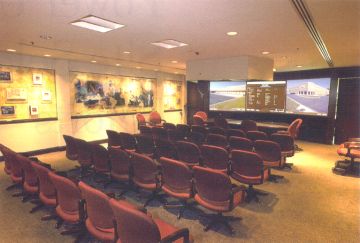
T |
he California blackouts and the state’s continuing electricity crisis took center stage at the IOU-EDA Winter Forum, held on Feb. 21-23 in San Diego, and these problems bring to the surface an important question for site selectors: Will utilities in a deregulated market be capable of providing the service my company needs? Many technology firms already located in California’s Silicon Alley are asking the same question.
Deregulation and the California experience has, more than anything else, put an emphasis on utilities’ role in site selection. Not only is reliable and redundant electricity now a bigger concern, but new services are coming to the forefront that site selectors must take into consideration. For instance, many utilities in deregulated markets have developed energy-saving services to help corporate clients save on their utility costs. And such incentives as special rates for industrial customers as well as energy efficiency programs and load monitoring services, are becoming commonplace.
“Line extensions and rate cuts have been replaced with a more comprehensive approach to satisfying prospects,” says Donna Buchheit, manager of economic development with Allentown, Pa.-based PPL Utilities (www.pplweb.com) and president of IOU-EDA. “We can work with the prospect to identify electricity choice options by providing lists of energy suppliers so they can shop to lower their power costs.”
Though such services can make the process of locating facilities more involved, they can also mean better opportunities through a more competitive marketplace. “Deregulation has helped us focus on the ways we can help reduce the bottom-line project investment for a prospect,” Buchheit notes. “At the same time, when we are successful we also meet the needs of our investors by increasing shareholder value.”
Site Selectors’ Point of Contact
Deregulation, however, is not the only factor changing the role of utilities in the site selection process. With shorter turnaround times, expanding companies need quick, accurate assistance without getting tangled in the red tape of state and local governments. Utilities are coming to the rescue.
“Utilities play a critical role in the site selection process, particularly as chief coordinator and project facilitator,” says Buchheit. “We coordinate projects with our state and with local groups to ensure that the prospect’s needs are met in the best and most efficient way possible. As a first point of contact, we are a full-service partner in the site selection process. This role is even more important than ever before as plant location projects become increasingly fast-tracked.”
Many utilities have made major strides in becoming the first point of contact to move the process along more quickly. For example, Plainfield, Ind.-based Cinergy/PSI (www.cinergy.com) implemented its Site Consultant Strategy to develop long-term relationships with site consultants. The program aligns specific Cinergy staff with specific site consultants so that consultant always has a point of contact within the state and within the organization. As Cinergy’s Manager of Marketing Scott Fulford told Site Selection in the Top 10 Utilities story (September 2000), “That way the site consultant can call his specific rep, and he knows the individual he’s working with, and he knows that he can trust that person and that that individual will be responsive to him.”
Internet, Utilities and Sites — Oh My!
Responsiveness has, in fact, become a make-or-break characteristic for economic developers, and that’s why many utilities are taking the lead in moving toward Web-based response systems. “Utilities, as are most economic developers, are looking to the Internet as the most efficient method to market and communicate with their clients,” explains Fulford. “There is a lot of attention being given to Web-based programs and activities.”
Many utilities, including several of Site Selection‘s Top 10 utilities, have placed demographic statistics and building and site information online to help site selectors find exactly what they need more quickly. “In general, we are seeing shorter timetables on projects,” says Becky Blaylock, vice president of community and economic development with Georgia Power (www.georgiapower.com/grc). “We must respond more quickly, which means having available data and information at our fingertips.”
 Although Blaylock sees the Internet as more of a screening tool than a selection tool, she insists that “making the short list through ‘electronic’ screening is critical.” Her group, in fact, maintains economic development demographics on 260 communities and all 159 counties in Georgia as well as data on more than 500 available buildings and 650 sites, which are updated on a weekly basis. Georgia Power has developed marketing materials for the available buildings in its service territory, and there are building flyers and virtual tours of “hot buildings” on the group’s Web site.
Although Blaylock sees the Internet as more of a screening tool than a selection tool, she insists that “making the short list through ‘electronic’ screening is critical.” Her group, in fact, maintains economic development demographics on 260 communities and all 159 counties in Georgia as well as data on more than 500 available buildings and 650 sites, which are updated on a weekly basis. Georgia Power has developed marketing materials for the available buildings in its service territory, and there are building flyers and virtual tours of “hot buildings” on the group’s Web site.
Other utilities are providing much the same. Cinergy’s Fulford says that his group recently added GIS mapping and demographics to the Indiana portion of its Web site, and “we’re working to bring the Greater Cincinnati side the same programming,” he adds. The group has also instituted a program called Permits to Projects, which works with communities to define and identify sites ready for prospects and clients. Permits to Projects minimizes delays in zoning and permitting and helps with construction plans for companies interested in the area.
“The program has a rigorous set of criteria that must be met to receive our approval, but when completed, the site is definitely ready for promotion to their prospects,” says Fulford. “Also, because of the involvement with a contractor, the program offers a better alternative than putting up an ‘inexpensive’ spec building.”
PPL recently created its SelectSites and SelectTech Sites programs. Through these programs, the utility works with local communities to ensure that they are ready for certain types of plants by certifying locations based on an established set of rigorous criteria.
Providing Ready-to-Go Properties
Matt Jackson, solutions manager with Deloitte & Touche Fantus’ (www.deloitte.com) Los Angeles office, says that his group’s traditional site selection process has drastically been cut in terms of time allowed for turnaround and that utilities need to be more involved in the building of spec facilities. “Phase I, which is our screening and filtering or narrowing down to the short list phase, used to run four to six weeks, but now that’s about two weeks,” he explained. “Phase II — going into the field — has also shrunk, so we’ve started to front-load our projects. Our timeline requirements don’t allow us to look at greenfield sites. We need things that are ready to go.”
Such efforts are being made by many utilities, especially in smaller markets. In Site Selection‘s survey of utility companies last year, American Electric Power Co. of Charleston, W.Va., reported that it had financed two new 50,000-sq.-ft. (4,645-sq.-m.) shell buildings.
Carolina Power & Light developed an Industrial Building program in which it provides financing for these developments. The group reported that it had partnered in two spec buildings through the program, which resulted in a new 75,000-sq.-ft. (6,968-sq.-m.) spec facility in Wilmington, N.C., and a 46,000-sq.-ft. (4,274-sq.-m.) facility in Columbus County, N.C. And since North Carolina had 18 of Site Selection‘s Top 100 Small Towns for new and expanded facilities (March 2001), it seems that these spec projects are exactly what site selectors need.
Work-force Development Programs
In other endeavors to fulfill company needs, utilities are delving into new arenas. With the biggest concern for most operations being the need to find skilled labor, many utilities are taking a larger role in work-force development for their service areas.
Georgia Power, for example, created an educational services group to support and enhance the educational system in the state. Through this group, Georgia Power works within communities as well as at the state level to help communicate the need for stronger, more responsive systems that create seamless educational opportunities “for all learners, birth to senior citizens,” says Blaylock.
Recently, Georgia Power added a new Web site called Learning Power for its education efforts in the state. And Georgia Power’s CEO David M. Ratcliffe now serves as the vice chair for the Georgia Partnership for Excellence in Education, which is a public-private partnership to address educational issues in the state.
In general, utilities are forming partnerships with local economic developers as well as corporate clients to make the site selection process easier. As deregulation moves forward and turnaround times shrink, these partnerships will become crucial for site selectors. And the efforts utilities put into these partnerships will mean only more success for everyone in the future.
“Site Selectors work with those whom they can trust and count on,” explains Cinergy’s Fulford. “Our programs and our efforts tell them that they can trust us and count on us. When asked for assistance, no one wants to hear excuses or get half-hearted efforts. Our organization operates with the premise that we can provide that assistance, and the site selectors say, ‘Thanks.’ “

